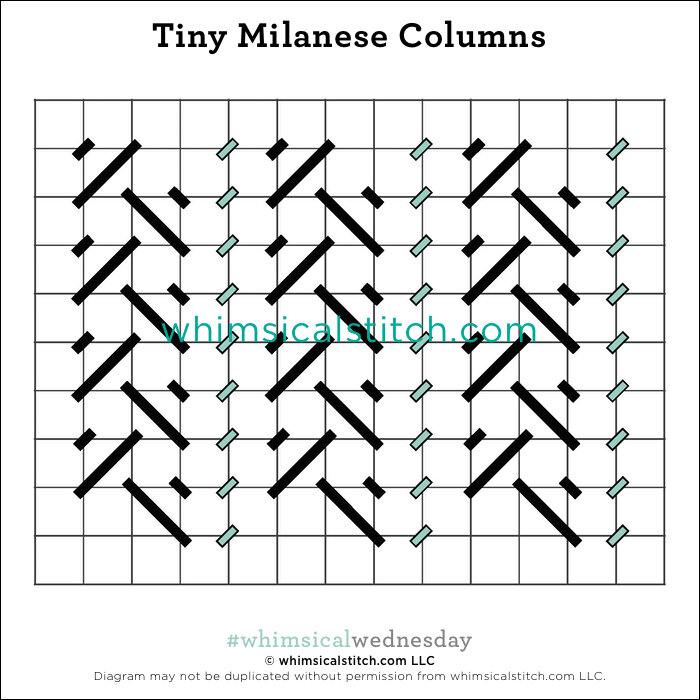I have a weird thing about Satin Stitches. And that’s where I make things complicated…for myself.
I knew I wanted to do vertical columns three rows wide for the house in the photo. A Satin Stitch was the obvious choice. For clarity, Satin Stitches are diagonal stitches over the width of an area. They are great for columns and I frequently use them for columns anywhere between 2-4 rows. Satin Stitches can be found on page 18 in my first book as well as the Essentials guide. An alternating Satin Stitch can be found here.
Here’s where I make things complicated. I have a weird aversion to the simplest of Satin Stitches. I feel like I should do more. As a stitcher, I don’t like to fall back on the same thing (except for basketweave) when there are cute alternatives. And, as a teacher, I like having a bigger basket of tricks to pull from. And that is how I landed on today’s stitch. It’s a scaled-down version of a stitch I’ve seen a lot of on pinterest.
The stitched sample is three plies of white Splendor (black lines) and Petite Silk Lame (aqua lines) on another adorable Plum Stitchery holiday ornament.
It’s already in an upcoming stitch plan for some Charley Harper birds. The student will be using silk floss and a still to be determined metallic. It will also work well for clothing, especially pants, with Vineyard Silk (black lines) and a Kreinik metallic (aqua lines). I think it will make a beautiful bedspread or tablecloth with silk or cotton floss (black lines) and Soie Perlee (aqua lines).
This stitch diagram, along with all other #whimsicalwednesday and #smallspacesunday stitch diagrams, can also be found on a Pinterest board here. Be sure to follow whimsicalstitch.com on Facebook, Pinterest, Instagram, and Twitter.
IIf you like what you see on this blog, there's more: Mary’s Whimsical Stitches Volume 1 is a contemporary how-to collection of more than 250 stitches for stitchers regardless of skill level. The book includes updated and sequenced diagrams from this blog, all-new stitches, and a chapter on the basics of needlepoint; Mary’s Whimsical Stitches Volume 2 features chapters on Balanced, Beading, Diagonal, Layered, Oblique, Small, and Straight stitches.
Also, you can download for free the first chapter from my first book which covers basic needlepoint stitches and stitch compensation techniques along with new top-line information on needlepoint materials and tools, how to handle threads, and other helpful needlepoint resources.
whimsicalstitch.com also sells Stitch Guides and Stitch Concepts for Melissa Shirley Designs, Zecca Designs, Sandra Gilmore, Purple Palm, Maggie, and Penny MacLeod, and many more. Click here to see the newest guides and click here to see the entire collection.
I hope you have the perfect spot for this stitch! Please enjoy! Have a wonderful #whimsicalwednesday!
A Note about Diagrams
I use color in diagrams to make them as clear as possible. The primary function of different colored lines is to illustrate a stitch sequence. For example, layering of colors demonstrates you add them in that order. They can also provide ideas on how to integrate additional threads (one line for each color). Or, you can use the same thread for all color lines. That's where I encourage you to use your imagination for the space you are stitching!



